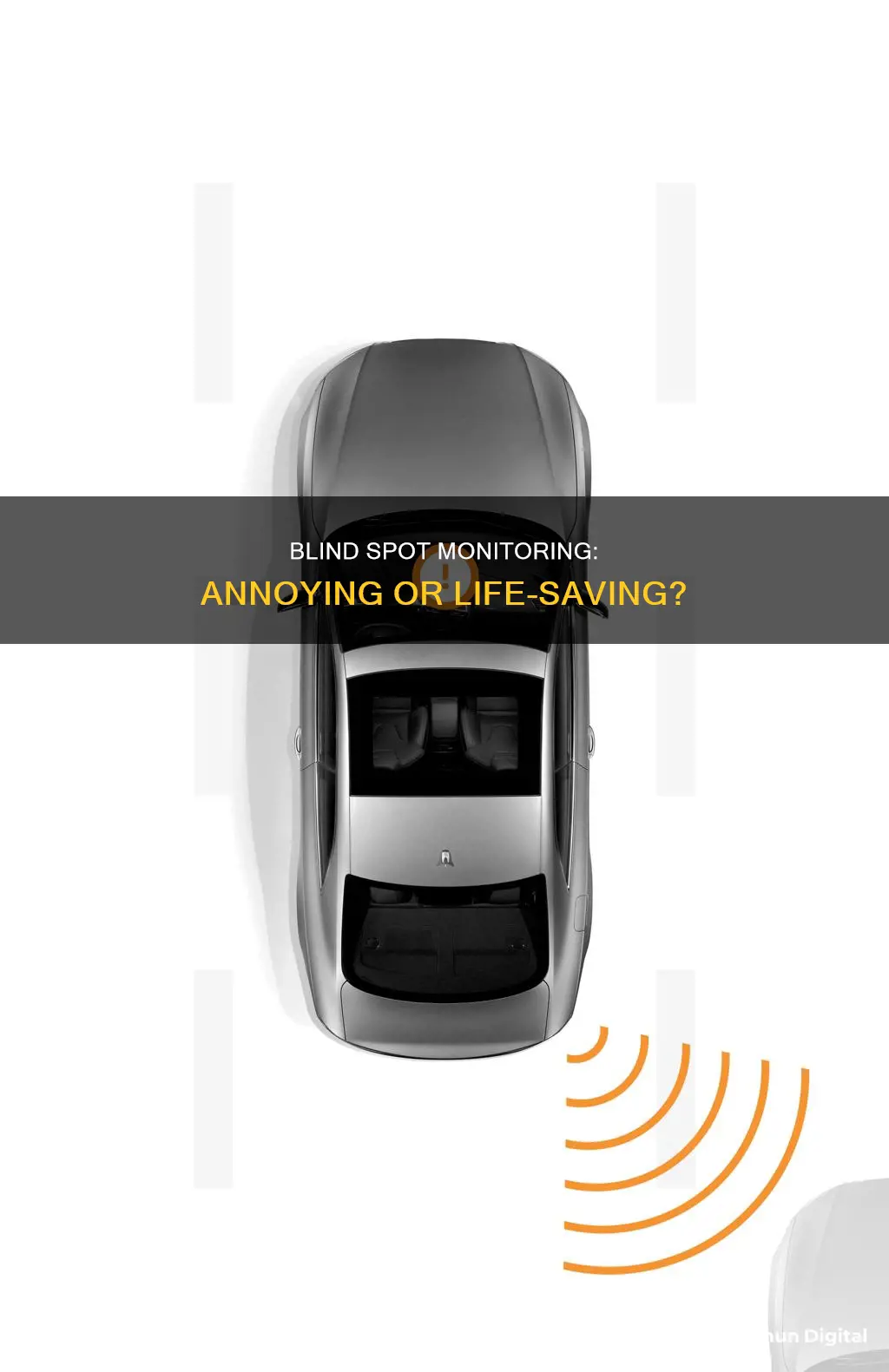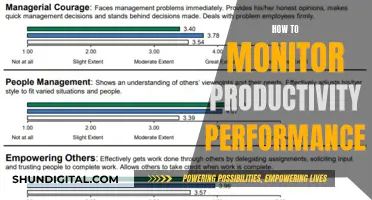
Blind-spot monitoring is a useful feature to have in a car, but is it annoying? Some drivers find the warning chimes that accompany the flashing lights in the wing mirror annoying. While the feature is designed to increase safety by alerting the driver to vehicles that may be in their blind spot, it is not a substitute for checking mirrors and looking over one's shoulder. The system may also be seen as annoying because it is not always reliable, as it can struggle to detect fast-moving vehicles and motorcycles. Additionally, blind-spot monitoring systems work best at highway speeds, so their usefulness may be limited when driving in the city.
| Characteristics | Values |
|---|---|
| Is it annoying? | Some users find the warning chimes annoying. |
| Is it useful? | Blind-spot monitoring is a useful tool to help drivers be more aware of their surroundings. |
| Is it safe? | Blind-spot monitoring is not a substitute for checking mirrors and looking over one's shoulder. |
| Is it reliable? | Blind-spot monitoring is not foolproof but it is reliable. |
| Is it standard? | Blind-spot monitoring is generally not a standard feature. |
What You'll Learn
- Blind spot monitoring is not a replacement for checking mirrors and turning your head
- The system may not detect fast-moving vehicles or motorcycles
- It's important to keep the sensors and cameras clean and clear of obstructions
- Blind spot monitoring is most effective at highway speeds
- The system can be annoying when paired with warning chimes

Blind spot monitoring is not a replacement for checking mirrors and turning your head
Blind-spot monitoring (BSM) is a useful feature to have in your car, but it is not a replacement for checking mirrors and turning your head. While BSM can alert you to vehicles in your blind spot, it is not perfect and there are times when you shouldn't rely on it. For example, BSM may not detect fast-moving vehicles or motorcycles, and it may not work properly in poor weather conditions like fog or snow. Additionally, BSM systems only work at speeds greater than 20 mph, so they are not useful in city driving or at low speeds.
One benefit of BSM is that it can reduce the stress of driving in close quarters. It can also provide an early warning if a vehicle is about to enter your blind spot, giving you more time to respond. However, BSM should be used as a supplement to, not a replacement for, safe driving practices. It is still important for drivers to use their turn signals, watch their mirrors, and look over their shoulders when changing lanes.
Some BSM systems offer more advanced features, such as haptic alerts or autonomous steering or braking to prevent collisions. However, even these more sophisticated systems can be overridden by the driver. While BSM can provide added safety, it is not a substitute for a driver's own vigilance and safe driving practices.
It's also important to note that BSM systems may not always be accurate or reliable. They can be affected by outside circumstances, such as bright lights or dirt and obstructions on the sensors and cameras. Additionally, each system has its own maximum speed differential limit, which means it may not detect vehicles moving significantly faster than you. So while BSM can be a helpful tool, it should not be solely relied upon.
In conclusion, while blind-spot monitoring can be a valuable safety feature, it should not replace the need for drivers to check their mirrors and turn their heads. BSM has limitations and can be affected by various factors, so it's important for drivers to remain vigilant and practice safe driving habits.
Setting Up Monitors with a Mixer: A Step-by-Step Guide
You may want to see also

The system may not detect fast-moving vehicles or motorcycles
Blind-spot monitoring (BSM) is a useful feature for drivers, but it does have some limitations and drawbacks. One notable issue is its difficulty in detecting fast-moving vehicles and motorcycles. This is mainly due to the speed differential limit of the system, which varies depending on the specific BSM in question. When a vehicle is moving significantly faster than the equipped car, the blind-spot monitoring system may not detect it in time, potentially resulting in a late alert for the driver.
The system's limitations with fast-moving vehicles can be attributed to its reliance on visual cues and the placement of sensors. As the speed differential increases, the time available for the system to detect and alert the driver decreases. This can be particularly problematic when merging onto a busy highway, where vehicles are likely to be travelling at higher speeds. In such cases, the alert from the blind-spot monitoring system may come too late for the driver to take evasive action.
Motorcycles also pose a unique challenge for BSM systems. In a study conducted by the American Automobile Association (AAA), it was found that motorcycles were detected 26% later than passenger vehicles. This delay could be critical in situations where a motorcycle is approaching at a high speed or is already within the blind spot. The smaller size of motorcycles compared to cars may contribute to this detection delay.
To compensate for these limitations, drivers should remain vigilant and continue to practice safe driving habits. This includes checking mirrors, using turn signals, and looking over their shoulders when changing lanes or turning. While BSM can provide an extra layer of safety, it should not be solely relied upon. Keeping the sensors and cameras of the BSM system clean and free of obstructions is also important for optimal performance.
Additionally, some BSM systems offer more advanced features, such as autonomous steering or braking, to prevent collisions. These systems can subtly intervene by nudging the vehicle back towards the centre of the lane or applying brake pressure to specific wheels. However, even with these advanced features, the limitations in detecting fast-moving vehicles and motorcycles remain a consideration.
Monitoring App Data Usage: A Comprehensive Guide
You may want to see also

It's important to keep the sensors and cameras clean and clear of obstructions
Blind-spot monitoring (BSM) is a useful safety feature that can help prevent accidents, but it's important to remember that it's not a substitute for safe driving practices. One key aspect of maintaining the effectiveness of BSM is to ensure that the sensors and cameras are clean and unobstructed. Here's why this is important:
Sensor and Camera Technology
BSM systems use a combination of sensors and cameras to detect vehicles or other objects in a driver's blind spot. The sensors are typically embedded in the side-view mirrors or the rear bumper of the vehicle. The cameras are often mounted in the side-view mirror housings. By utilising these sensors and cameras, BSM provides drivers with an early warning system for objects that may be outside their field of vision.
Keeping Sensors and Cameras Clear
Over time, sensors and cameras can become obscured by dirt, dust, snow, ice, condensation, or other debris. This obstruction can significantly impact the functionality of the BSM system, leading to potential errors or delays in warnings. A blocked sensor or camera lens can impair the system's ability to detect approaching vehicles or objects, reducing its effectiveness in preventing collisions.
Regular Cleaning and Maintenance
To maintain the accuracy and reliability of BSM, it is essential to keep the sensors and cameras clean and clear of any obstructions. This involves regularly inspecting and cleaning them to remove any dirt or debris buildup. Additionally, it is crucial to ensure that the sensors and cameras are not covered or blocked by items such as stickers, decorative items, or hanging objects inside the car. By keeping the sensors and cameras unobstructed and functioning optimally, drivers can maximise the benefits of BSM and enhance their overall safety on the road.
Best Practices
While BSM is a valuable tool, it should be used in conjunction with safe driving practices. Drivers should still use their turn signals, check their mirrors, and look over their shoulders when changing lanes or turning. By combining BSM with cautious driving behaviours, motorists can further reduce the risk of accidents and improve their overall driving experience.
Monitoring App Bandwidth: A Comprehensive Guide to Track Usage
You may want to see also

Blind spot monitoring is most effective at highway speeds
Blind-spot monitoring (BSM) is a useful feature to have in your car, especially when driving on the highway. While it is not a substitute for checking mirrors and looking over one's shoulder, it is an added safety measure to compensate for human error. BSM is generally operational at speeds greater than 20 miles per hour, making it most effective at highway speeds.
BSM uses radar or ultrasonic sensors located inside the rear bumpers and cameras in the side-view mirror housings to detect vehicles within the monitored areas. When a passing vehicle enters a blind spot, BSM alerts the driver through a visual or audible warning. Some systems also offer haptic alerts, such as vibrations through the steering wheel or seat.
The larger your vehicle, the bigger the blind spot, and the more beneficial BSM can be. This is especially true when driving on highways, where the speed and flow of traffic can make it challenging to check mirrors and blind spots manually. BSM provides early warning notifications, increasing the time you have to respond and make necessary adjustments.
Advanced BSM systems can even provide steering assistance, subtly intervening with autonomous steering or braking input to prevent lane changes and potential collisions. These systems can nudge you away from the lane marker or steer you back to the center of the lane, helping to maintain a safe distance from surrounding vehicles.
While BSM is a valuable tool, it is important to be aware of its limitations. For example, BSM may struggle to detect fast-moving vehicles, and some systems have difficulty detecting motorcycles or similarly-sized objects. Additionally, BSM relies on clean and unobstructed sensors and camera lenses to function properly, so regular maintenance is essential.
In conclusion, blind-spot monitoring is most effective at highway speeds, providing drivers with early warnings, increased awareness, and added safety when operating their vehicles. However, it should be used as an aid, and drivers should still prioritize safe driving habits, such as using turn signals, watching mirrors, and looking over their shoulders when changing lanes.
Identifying DVI-D Ports on Your Monitor
You may want to see also

The system can be annoying when paired with warning chimes
Blind-spot monitoring is a safety feature in vehicles that uses sensors and cameras to detect vehicles in a car's blind spots and alert the driver through visual or audio cues. While this feature is meant to improve safety, some drivers find it annoying or even distracting. One reason for this is the inclusion of warning chimes that can be overly loud or persistent.
Some drivers find the warning chimes included in blind-spot monitoring systems to be unnecessary and annoying. In some cases, the chimes may be too loud or difficult to adjust, leading to a frustrating driving experience. Additionally, the chimes may only provide audio cues when the turn signal is activated, which can be problematic if the driver fails to use their turn signal before changing lanes. This design choice may be due to the intention to prevent false alarms when the driver has no intention of changing lanes. However, it also means that the audio alert may come too late to prevent an accident effectively.
The effectiveness of blind-spot monitoring systems in detecting fast-moving vehicles has also been called into question. Studies have found that these systems often alert drivers too late about approaching vehicles in adjacent lanes, particularly when it comes to motorcycles. This delay in alerts can be a significant issue when merging onto busy highways, where vehicles are travelling at high speeds. As a result, drivers may still need to rely on traditional shoulder checks and mirror adjustments to ensure their safety.
While blind-spot monitoring systems aim to enhance safety, the inclusion of warning chimes can be a point of contention for drivers. The chimes may be seen as unnecessary or even distracting, especially if they are too loud or difficult to adjust. Additionally, the timing of the audio alerts may not always be optimal, depending on the system's design. Therefore, it is important for drivers to understand the limitations of their blind-spot monitoring systems and continue to follow safe driving practices, such as checking mirrors and blind spots, to ensure their safety on the road.
LCD Monitors: Radiation Emission and You
You may want to see also
Frequently asked questions
Blind spot monitoring can be annoying for some drivers due to the inclusion of warning chimes, which are designed to alert the driver of potential dangers. However, others find it useful and reassuring.
Blind spot monitoring uses sensors and sometimes cameras to detect vehicles in a car's blind spot. When a vehicle is detected, the system alerts the driver through visual and/or audible warnings.
Blind spot monitoring is a valuable safety feature, especially for larger vehicles with bigger blind spots. While it should not replace proper mirror adjustment and shoulder checking, it can provide an extra layer of protection and help reduce lane-change collisions.
Blind spot monitoring systems may struggle to detect fast-moving vehicles and motorcycles, and their effectiveness can be reduced in certain conditions like fog or snow. They are also primarily designed for highway use and may be less useful in city driving.
It is important to keep the sensors and cameras of the system clean and clear of obstructions. Drivers should also be aware of the system's limitations and continue to follow safe driving practices, such as using turn signals and checking mirrors and blind spots before changing lanes.







